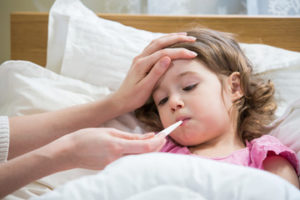Illness abounds this fall and has been quite relentless. Not only do we understand the frustration of illness, but we also understand the worries and fear that sometimes come along with it. We wanted to take a moment to address one of the top concerns of parents, which is fever.
Fever is defined as anything greater than 100.4°. Fever is like the body’s superpower to fight off illness. We don’t want to take away fever if the body is using it to fight off illness. In fact, it would be more worrisome if the body couldn’t mount a fever if it really needed it. Fever shows that your immune system is working properly. Many parents worry about the height of the fever, but just to reassure many parents, even a 104 fever is considered a moderate fever in pediatrics. When you take acetaminophen or ibuprofen, it is expected that the fever will only decrease by 1° or 2°. For example, if the fever were 104 then it might decrease to 103°. This means that the body still wants to fight off the fever, but we are reducing the fever enough to make the child more comfortable and help them to drink and stay hydrated.
Many parents think it’s better not to give a fever reducer before coming to our office because they worry that we may not see the severity of the illness that they are seeing at home. Although we appreciate that you want us to see the untreated fever, we encourage you to give fever reducers if they are necessary before coming to the visit. One of the reasons for this is that we want to be able to see that a child can perk up just slightly when on a fever reducer.
We understand that children are going to look like wet noodles when they are 103 or 104. We want to see what happens when the temp comes down to 101 or 102. Does the child perk up slightly? Do they want to play for five minutes, or do they ask for a specific TV show? If they don’t have that small perk-up period, that’s when we worry. You want to see the ups and downs, and ebbs and flows of illness. When there are ups and downs, we are actually quite reassured that the body is doing the right thing to fight infection. We become more concerned as doctors when we don’t see those ups and downs.
The main treatment for fever is hydration so that the body does not become dehydrated. The body loses water through the skin when there is a fever. If you’ve given fever reducers, and it’s not time to give anymore, you can put your child in a nice warm shower to dilate their skin and let some of the heat out of their pores.
We also have a lot of questions about ibuprofen and acetaminophen. These two fever reducers do not interact in any way. For instance, you can give acetaminophen three minutes after ibuprofen or three hours after ibuprofen. The main important part is that the medication itself stays at the same interval from itself. Acetaminophen has to be four hours between doses and ibuprofen needs to be six hours between doses.
Fever is known to spike in the late afternoon or evening. Many parents will come in to see us in the morning, and their child will look pretty good. Later in the day, their child will take a nap and wake up and look like a wet noodle again. This causes so much concern that maybe the illness has taken a turn for the worse regardless of their child being checked in the morning. This is not necessarily the case, and we always expect the fever to rise in the later afternoon, and the child to look a little worse than they did in the morning. Please be reassured that this is OK. This does not mean that your child is worsening or unsafe. Your body is just following the pattern that it needs to take to fight off the illness.
We are currently inundated with illness, phone calls, and antibiotic shortages in the state. We appreciate your patience as we try to muddle through this new challenging time.
If you have further questions, let us know. Be reassured, however, that fever means the body is doing what it is supposed to do to fight off illness in the best way it can.
CLICK HERE TO VIEW an informative video!
